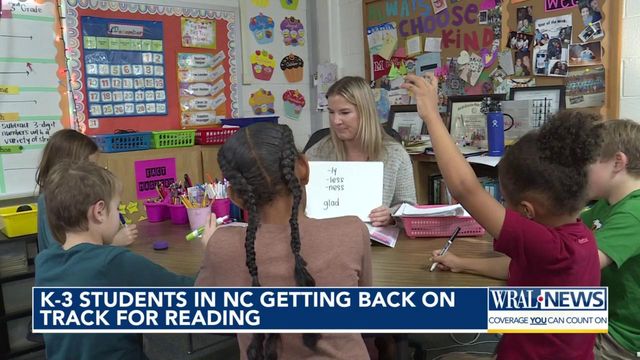Reading readiness rises in NC's K-3 classrooms, new data shows
More than 43,000 North Carolina kindergarten through third graders are meeting benchmarks in reading, compared to last year, new data shows.
It's a sign of academic improvement as the state -- and world -- worry about pandemic-related academic declines. At the same time, North Carolina is making faster gains than the average school systems that use the same reading test, as the state makes changes to how it teaches kids to read.
The North Carolina Department of Public Instruction released an analysis Wednesday of beginning-of-the-school-year test data for kindergarten through third graders.
Compared to the beginning of the past two school years, more students are on track with where educators want them to be when it comes to reading.
"There's a lot of really wonderful movement," State Board of Education Member Jill Camnitz said, following the department's presentation of the data to the board Wednesday.
Just more than 434,000 North Carolina students completed the reading test, provided by Amplify and known as DIBELS 8. North Carolina is a major user of the test. Nationally, school systems from 50 states, representing 1.6 million students, use it.
Across all North Carolina schools, 52% to 54% of first through third graders were meeting test benchmarks at the beginning of the year, meaning they're where educators want them to be for the beginning of the school year.
That's up from 48% to 51% last year and 38% to 45% the year before that. It's also now a touch better than the average of the rest of the nation, with 50% to 53% of students meeting benchmarks at the beginning of this school year. North Carolina's students made gains twice as fast as the rest of the nation, as well.
Fewer kids were held back grade in reading this year. About 18,000 students were "reading retained," down from about 23,000 students last year and 28,000 students the year before that.
Not all of the data showed success.
Gains have also been made in kindergarten, but North Carolina still lags far behind the rest of the nation.
Just 33% of kindergarteners were where educators want them to be at the beginning of this year, compared to 40% nationally.
Far fewer Black, Hispanic and American Indian students are where educators want them to be, compared to white and Asian students. Well more than half of white and Asian students are on track, but less than half of Black, Hispanic and American Indian students are on track.
At the same time, students in all demographics have made larger gains than their national counterparts.
The department is attributing the success it's had to its new training for teachers on how to teach reading. The training emphasizes established brain science, from breaking down letters and sounds for students to ensuring students build vocabulary and reading comprehension. It differs from some once-popular reading techniques that have involved word memorization, guessing words using context clues, or having struggling readers read independently.
Board members emphasized ensuring teachers have easy access to the test data for their classrooms, including ready-made analysis of it that could help teachers understand their classrooms in new ways.
The new teacher training, which is one-time and lasts two years, is just a start, Camnitz said.
"We are not done when the last cohort finishes (the training)," she said. "We are only just beginning ... We are going to be talking about this for a long time."












